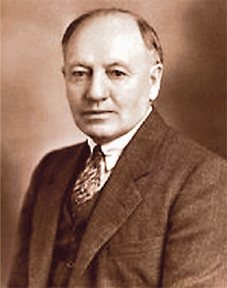Passion and Focus

“If a man is called to be street sweeper, he should sweep streets even as Michelangelo painted, or Beethoven composed music, or Shakespeare wrote poetry. He should sweep streets so well that all the host of heaven and earth will pause to say, here lived a great street sweeper who did his job well.”
–Martin Luther King, Jr. (American Baptist Minister, Social Activist and, in 1964, Winner of the Nobel Peace Prize, 1929-1968)

Focus + Will = Action

“For purposes of action nothing is more useful than narrowness of thought combined with energy of will.”
–Henri-Frédéric Amiel (Swiss Philosopher, Writer and Poet, 1821-1881)

“Amiel’s Journal: The Journal Intime of Henri-Frédéric Amiel” (Henri Frédéric Amiel)
Clarity and Consistency

“If one asks for success and prepares for failure, he will get the situation he has prepared for. For example: A man came to me asking me to speak the word that a certain debt would be wiped out. I found he spent his time planning what he would say to the man when he did not pay his bill, thereby neutralizing my words. He should have seen himself paying the debt.”
–Florence Scovel Shinn (American Artist, Metaphysics Teacher and Author, 1871-1940)
Concentrated Power

“Concentrated power is silence. Diffused power is noise…..When you reach the place of silence in mind, you have reached the place of power, the place where all is one.”
–Baird Spalding (American Explorer, Spiritual Seeker and Writer, 1857-1953)
Watch Your Basket Grow

“Concentrate: put all your eggs in one basket, and watch that basket.”
–Andrew Carnegie (Scottish-born American Steel Magnate and Philanthropist, 1935-1919)
The Value of Moments

“The value of moments, when cast up, is immense, if well employed; if thrown away, their loss is irrevocable.”
–Philip Dormer Stanhope, 4th Earl of Chesterfield (English Statesman and Author, 1694-1773)
Dream, Focus, Act and Simplify

“I learned this, at least by my experiment: that if you advance confidently in the direction of your dreams, and endeavor to live the life which you have imagined, you will meet with a success unexpected in common hours.
You will put some things behind, you will pass an invisible boundary; new, universal and more liberal laws will begin to establish themselves around and within you; or the old laws will be expanded, and interpreted in your favor in a more liberal sense, and you will live with the license of a higher order of beings. In proportion as you simplify your life, the laws of the universe will appear less complex, and solitude will not be solitude, nor poverty, nor weakness.
If you have built castles in the air, your work need not be lost, that is what they should be. Now put foundations under them.”
–Henry David Thoreau (American Essayist and Philosopher, 1817-1862)
Food Additives, Food Colorings and Hyperactivity

Regular readers will know that I am very interested in the impact of food and food additives on cognition and behavior. Unfortunately it is a field that has generated more heat than light, with some patients associations and commercial organizations providing rather unbalanced assessments about the whole issue and how best to deal with it.
What we do on this website is to provide you with information that has a solid foundation. A good example is a new study published this week in the Lancet by a team of researchers from Southampton University in the United Kingdom. (The full article is available here).
An alarming number of foods contain artificial food color and additives (AFCAs), and there has been a great deal of concern about their potential impact not only on behavior, but also on the developing brain.
A study published three years ago examined the impact of specific mixtures of additives on hyperactivity in three-year-old children. It was an important piece of work, but the worry was that the study focused on parental rather than objective ratings of hyperactivity. Though parents are usually very good at observing their own children, most of us also have our own ideas about the things that may cause problems.
In this new study was sponsored by the British Food Standards Agency and the researchers looked at the effects of additives on changes in children’s behavior in a community-based, double-blinded, placebo-controlled, crossover trial.
The study involved 153 children aged 3, plus 144 children aged 8-9. They were given either a drink containing sodium benzoate plus one of two AFCA mixes, or a placebo drink. The two AFCA mixes contained:
- Mix A – included 20 mg of artificial food colorings (5 mg sunset yellow [E110], 2⋅5 mg carmoisinetartrazine [E102], and 5 mg ponceau 4R [E124, and 45 mg of sodium benzoate [E211]. (These were the same ingredients used in the previous study). [E122], 7⋅5 mg
- Mix B was designed to be what the average 3 year-old and 8-9 year old may be consuming today, and included 30 mg of artificial food colorings (7⋅5 mg sunset yellow, 7⋅5 mg carmoisine, 7⋅5 mg quinoline yellow [E110], and 7⋅5 mg allura red AC [E129]) and 45 mg of sodium benzoate.
The children’s behaviors were measured by a “global hyperactivity aggregate” (GHA) that is based on teachers’ and parents’ ratings. The older children also received a computerized test for attention.
The main findings were that:
- Mix A had a significant adverse effect on children in GHA for all the 3 year-olds, compared to the placebo.
- Mix B produced mixed results for 3 year-olds
- Both Mix A and Mix B had significant adverse effects on the 8-9 year olds, compared to the 8-9 year-olds on the placebo
- Children vary greatly in their levels of adverse effects from consuming AFCA
So this new research indicates that foods containing AFCAs may fuel hyperactive behaviors in children from early to middle childhood. An important point is that AFCAs may impact any child: the effect is not restricted to children who are already hyperactive or have attention-deficit/hyperactivity disorder (ADHD). The problem with hyperactivity is not so much the challenge of living with an overly energetic child, but rather the impact of hyperactivity on development and education, particularly on reading skills. The hyperactive child may not get the full benefit of a conventional education.
The researchers do not yet know whether their findings apply to older children. But they raise the question whether complete withdrawal of AFCAs from the food supply might decreases the overall rate of hyperactivity in the population.
However, they ask whether the general levels of hyperactivity in children in the general population might not go down significantly if AFCAs were withdrawn completely.
Brain Training and the Paradox of Aging

For centuries, people in cultures throughout the world have believed that increasing age is associated with increasing wisdom. Not just knowledge and experience, but wisdom. Is this an old wives’ tale, or is there something to it?
There is growing evidence that as we age our brains actually become stronger. Everyone missed it, because the emphasis was on memory, concentration and thinking speed, and those may all deteriorate with age. What changes is that as we age we become more efficient at making associations rather than thinking linearly. we also recruit regions of the brain that may have lain dormant for years. At the same time, different types of mental training, including meditation, can improve many aspects of our cognitive abilities, and may also enrich and even grow appropriate regions of the brain.
Some new data from a study being conducted at Wake Forest University Baptist Medical Center in North Carolina suggests that it is possible to use a fitness program for your brain that can improve thinking skills, attention and concentration as reliably as lifting weights can increase muscle strength.
Preliminary findings from the study, which used functional magnetic resonance imaging (fMRI) to record brain activity, were presented last week at the Organization for Human Brain Mapping conference in Chicago.
As we age, we do experience changes in how we perceive the information that our senses gather from the environment. As I mentioned older adults combine information from the different senses more readily than do younger adults. This is known as sensory integration, and the down side is that it can lead to difficulties in blocking out distracting sights and sounds while still maintaining focus on important information. You are probably familiar with the “Cocktail Party Phenomenon.” You are in a loud room, but because someone is saying something interesting, you are able to block out uninteresting information. This technical term for this is cortricofugal inhibition. As we get older it gets more difficult to do the inhibiting.
The Brain Fitness in Older Adults (B-fit) study has been designed to establish whether eight hours of brain exercise can improve the ability of healthy older adults, ages 65 to 75 years, to filter out unwanted sights and sounds.
The B-fit study uses fMRI to visualize blood flow and brain activity to determine how attention training affects brain function. The training involves either a structured one-on-one mental work-out program or a group brain exercise program. During the one-on-one sessions, the volunteers were asked to ignore distracting information and tasks get harder as the eight-week training progresses. For the group sessions, participants learn new information relevant to healthy aging and are then tested on their ability to apply the new information.
All participants had an fMRI scan during a distraction task. They had to look for target words or numbers while ignoring distracting sounds. The scans showed brain activity in areas related to both sight and sound. Follow-up fMRIs showed that in the group receiving the one-on-one training, activity related to sight was increased, while activity related to sound was decreased. In addition, performance on the task was improved.
So the data do indeed suggest that attention training is a way to reduce
older adults’ susceptibility to distracting stimuli and therefore help improve
concentration.
And what about wisdom?
I have written in Healing, Meaning and Purpose that “Wisdom is the integration of understanding:” making more new associations and drawing conclusions based on a new perspective is a gift of aging. The training enables us to make sense of and communicate our conclusions.
When it comes to the brain, use it or lose!
Yoga Improves Concentration and Motivation
 We know that hatha yoga can improve balance and flexibility, and there has been evidence that it can have more profound effects on the body and mind.
We know that hatha yoga can improve balance and flexibility, and there has been evidence that it can have more profound effects on the body and mind.
Now some new research confirms something else that we have suspected: it can also lessen anxiety and improve concentration and motivation in as little as eight weeks.
The research was presented in New Orleans at the 54th Annual Meeting of the American College of Sports Medicine. Researchers from California State University in San Bernardino wanted to quantify the benefits of yoga beyond just strength and flexibility.
The investigators tested 84 students during the second and eighth weeks of four, 10-week hatha yoga classes at the University. 93% of the participants were female, 45 percent were Hispanic, 35 percent “Caucasian,” seven percent African-American, and two percent Asian. The students averaged 24 years of age; most had at least three months of consistent yoga experience prior to the class. (Why the quotes around “Caucasian?” I just don’t like the term. I am white and not from the Caucasus. I am also a nit picky Virgo…)

Two weeks and again nine weeks into the class, participants completed three standard assessments to measure their concentration, motivation and anxiety level. The results were dramatic. In just eight weeks of practice they measured significant increases in all three areas.
The research will be expanded to include more men, and also to see how these findings can be applied to sports and clinical treatment.
The researchers have opened up a fascinating field for further study, and I shall continue to report on the data as it comes out.







